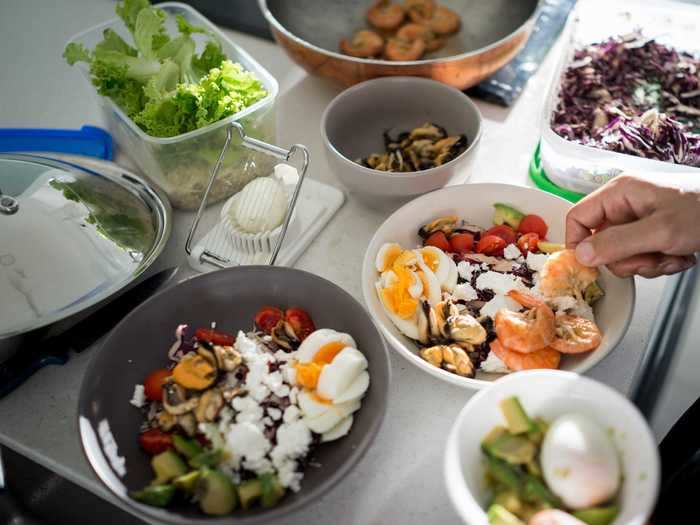
Carbs can show up in unlikely places, like cheese, nuts, and processed meats.Jayme Burrows / EyeEm/Getty Images
When you think of carbohydrates, you probably think of bread, pasta, and sweet treats like cookies or donuts.
But carbs are in a huge range of foods we eat, healthy and otherwise, from sugary pastries to starchy veggies to antioxidant-packed berries and even leafy greens.
Carbs are also a major source of energy.
While carbs are often vilified in current diet trends, they can be highly beneficial, fueling the body and mind, supporting athletic performance, and helping tissues such as muscle recover and grow.
Some people, such as those with diabetes or those doing a ketogenic diet, may opt to cut carbs or avoid them almost entirely.
Whether you love them or hate them, carbs can show up in some surprising places, even after accounting for fiber content.
From spices and sauces to meat products and milk, these are some foods you might not expect to come with carbs.

For people who might get 50-60% of their daily calories from carbs, a few extra grams might not seem like a big deal. But for anyone following a keto or low-carb diet, their carb intake might be just 5% to 20% of their daily calories.
That can mean as low as 25 to 50 grams of net carbs per day for a keto diet, and potentially up to 100 grams (of total carbs) per day for a low-carb or carb-cycling diet. For comparison, a small apple contains about 17 grams of net carbs.
That can add up quickly, even when avoiding carb-rich foods like grains, fruits, and legumes.
How do I count carbs?For counting purposes, carbs are typically categorized in two ways:
Total carbs: all the carbohydrates in a food
Net carbs: the total carbs minus the dietary fiber
Since dietary fiber isn't absorbed in the same way as sugars and other simple carbs, it doesn't have the same effect on blood sugar levels. As a result, many people who are limiting carbs don't include fiber in their carb count, and track their net carbs instead.
Some carb sources can contain both, so it's a good idea to check labels if you're not sure.
Some examples include...

If you're new to carb cutting, you might assume all animal products are low-carb or even carb-free.
You'd be wrong. Dairy contains natural sugar in the form of lactose.
Yogurt, which is produced by fermenting milk, also needs to have sugar to fuel that fermentation. The friendly bacteria in yogurt eat that sugar, meaning there's less of it in the final product, but some is left over.
Greek yogurt tends to have fewer carbs, since some of the lactose-containing liquids are strained out. Low-fat variations also tend to have slightly more carbs.
Perhaps less surprisingly, flavored yogurts can also carry a hefty carb load, with added fruit, sugar, or other sweeteners. For example:

With protein supplements, you might expect to get just what's in the name.
But muscle-building protein shakes often include carbs. This can sometimes come from the sugar content used to give the drinks an appealing flavor, but even low-sugar versions aren't exempt.
That's not necessarily a bad thing, since many people drink these products to refuel after a workout, and carbs are a great energy source for athletes. It is something to be aware of if you're tracking your macros, though. For example:
Protein bars are even more likely to have added carbs because of added ingredients like oats, rice flour, and starches.

Meat may be the last thing you'd expect to contain carbs. But processed meats, including salami, sausages, meatballs and anything that's brined could contain small amounts. That's because these types of meats often have fillers (like breadcrumbs) and flavorings (like sugar).
For example:

Nuts and seed are a source of healthy fats for any diet. Some of these nutritional powerhouses can pack some carbs, too, including:

Another under-the-radar carb source is seafood — most commonly shellfish, but also squid and octopus.
Like other living animals (including humans), aquatic critters store energy in their bodies as glycogen, a form of glucose or blood sugar. When most animals die, the glycogen in their muscles is depleted.
But it sticks around for shellfish and mollusks, meaning you get a bonus dose of carbs when you eat:

Like yogurt, milk contains natural sugar in the form of lactose.
That's without added sugar. Variations such as chocolate milk contain even more carbs.

Where there's dairy, there's lactose, and cheese is no exception. Aged cheeses tend to be fairly low-carb, but cheeses with some liquid have enough milk sugar to have a modest carb count.
Processed cheeses also contain carbs in the form of extra whey, flavorings, or other additives.

You might not even count them as a food, but if your daily vitamin regimen includes gummies, that's yet another hidden carb in your life. It often comes in the form of glucose, or pure sugar (so yes, those vitamins are basically candy).

Finally, it's not just your food that contains carbs — it's important to also pay attention to what you prepare it with. Many condiments, sauces, and even marinades have added sugar or other ingredients that can up your carb total.

Similar to condiments, spices and seasonings often aren't calculated when we consider the nutrients in a meal. These small but mighty ingredients can pack flavor but also a smattering of carbs, in some instances. A few examples are:
 I quit McKinsey after 1.5 years. I was making over $200k but my mental health was shattered.
I quit McKinsey after 1.5 years. I was making over $200k but my mental health was shattered. Some Tesla factory workers realized they were laid off when security scanned their badges and sent them back on shuttles, sources say
Some Tesla factory workers realized they were laid off when security scanned their badges and sent them back on shuttles, sources say I tutor the children of some of Dubai's richest people. One of them paid me $3,000 to do his homework.
I tutor the children of some of Dubai's richest people. One of them paid me $3,000 to do his homework. Top 10 Must-visit places in Kashmir in 2024
Top 10 Must-visit places in Kashmir in 2024
 The Psychology of Impulse Buying
The Psychology of Impulse Buying
 Indo-Gangetic Plains, home to half the Indian population, to soon become hotspot of extreme climate events: study
Indo-Gangetic Plains, home to half the Indian population, to soon become hotspot of extreme climate events: study

Copyright © 2024. Times Internet Limited. All rights reserved.For reprint rights. Times Syndication Service.